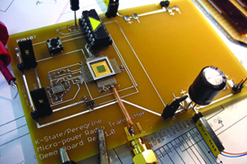Amped up
Energy-harvesting radios could make bridges safer, easier to monitor
 If changing the batteries in the remote control or smoke detector seems like a chore, imagine having to change hundreds of batteries in sensors scattered across a busy bridge.
If changing the batteries in the remote control or smoke detector seems like a chore, imagine having to change hundreds of batteries in sensors scattered across a busy bridge.
That's why K-State engineers are helping a semiconductor manufacturer develop an energy-harvesting radio. It could transmit important data -- like stress measurements on a bridge, for instance -- without needing a change of batteries, ever.
Bill Kuhn, K-State professor of electrical and computer engineering, and Xiaohu Zhang, master's student in electrical engineering, are developing an energy-harvesting radio for Peregrine Semiconductor, a San Diego-based integrated circuit manufacturer.
"This type of radio technology may exist in your house, for instance if you have a temperature sensor outside that radios data to a display inside," Kuhn said. "But those devices need to have their batteries changed. This radio doesn't."
Peregrine Semiconductor is looking at possible applications for the technology. This could include monitoring stress, temperature and pressure on bridges and other structures. Ron Reedy, Peregrine's chief technical officer, said developing autonomous sensors requires highly integrated, low power radio chips -- exactly the kind that K-State and Peregrine have demonstrated to NASA's Jet Propulsion Laboratory on Peregrine's trademarked UltraCMOS silicon-on-sapphire technology.
Meanwhile, the K-State engineers are looking at the design challenges of a radio system like this. Kuhn and Zhang have been working on the project for a little more than a year and are developing a demonstration to test how far the signals can travel from the sensors.
Zhang constructed a demonstration board using solar cells from inexpensive calculators to power the radio. The board has capacitors that capture and store the light energy to power the radio without a battery. Although this prototype captures and stores light energy, Kuhn said energy-harvesting radios could be powered a number of different ways, using electrochemical, mechanical or even thermal energy.
The demonstration board Zhang created includes a microprocessor to store data before it's transmitted via radio. The radio used is the "Mars chip" that Kuhn helped develop in a successful project he and a team from K-State, Cal Tech's Jet Propulsion Laboratory and Peregrine Semiconductor did for NASA. They developed a micro transceiver to use on Mars rovers and scouts.
In this way, Kuhn said the energy-harvesting radio they are working on now is an example of a NASA spinoff -- that is, technology developed for space exploration that can be used here on Earth.
When the stored data is ready to be transmitted, the radio sends out a data-burst. In Zhang's model, this happens every five seconds. That burst contains information such as the amount of stress or strain on the underside of a bridge. Kuhn said that it's kind of like sending a text message from one cell phone to another: After data are transmitted through the air, the recipient's cell phone turns that data back into text that can be understood.
Kuhn and Zhang are working to perfect the radio system design. This includes determining which frequencies to use based on how the environment affects radio waves indoors versus outdoors and looking at how noise and other factors affect the sensitivity of the receiver.
Because these sensors save data in their microprocessors, Kuhn and Zhang are also working on timing and wake-up commands that tell the sensors when to send the stored information to the receiver. Through engineering analysis, they are determining tradeoffs between power requirements, data-rate and transmission range issues.
Photo: This in-progress demonstration board is a key component of an energy-harvesting radio developed at K-State. Once finished, the board will include solar cells to power the radio.
Photo courtesy of K-State's department of electrical and computer engineering.